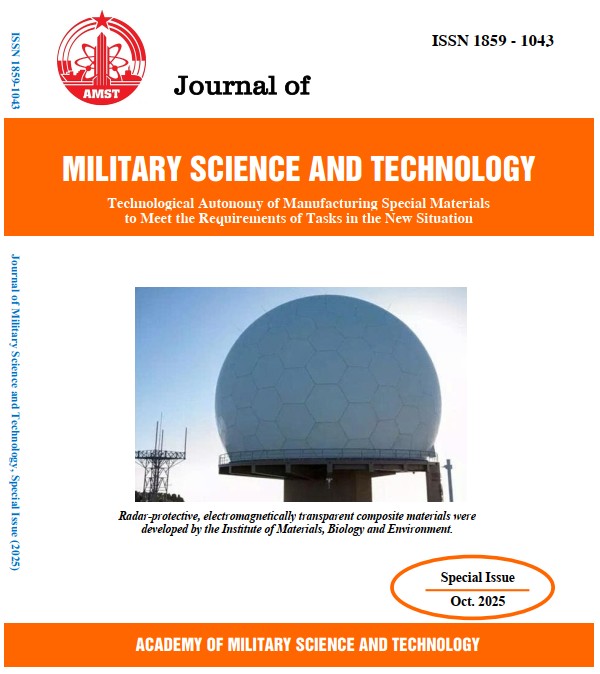Độ ổn định điện hóa cao của chất điện phân polymer gốc PEO cho pin Lithium kim loại
DOI:
https://doi.org/10.54939/1859-1043.j.mst.IMBE.2025.207-213Từ khóa:
Chất điện phân polymer; Pin Li-ion; LiTFSI.Tóm tắt
Chất điện phân polymer gốc polyetylen oxit (PEO), kết hợp lithium bis(trifluoromethanesulfonyl)imide (LiTFSI) và succinonitrile, rất hứa hẹn cho pin lithium-ion thể rắn nhờ độ dẫn ion và độ ổn định điện hóa vượt trội. Nghiên cứu này sử dụng phổ trở kháng điện hóa (EIS) và cửa sổ ổn định điện hóa (ESW) để đánh giá hiệu suất điện hóa của hệ thống điện phân. EIS thể hiện độ dẫn ion lớn hơn 10⁻⁴ S/cm ở nhiệt độ phòng do tác dụng dẻo hóa của succinonitril, làm giảm độ kết tinh của PEO, và sự tăng cường phân ly ion của LiTFSI. Các phép đo ESW cho thấy cửa sổ ổn định điện hóa đều lớn hơn 4,2 V, cho phép tương thích với catốt điện áp cao.
Tài liệu tham khảo
[1]. Y. Guo, H. Li, and T. J. A. M. Zhai, “Reviving lithium‐metal anodes for next‐generation high‐energy batteries”, Advanced Materials, Vol. 29, No. 29, p. 1700007, (2017).
[2]. I. Sumbulla, “Analysis of Prevailing Battery Innovations and Concept Technologies”, (2022).
[3]. K. Liu, Y. Liu, D. Lin, A. Pei, and Y. J. S. A. Cui, “Materials for lithium-ion battery safety”, Science Advances, Vol. 4, No. 6, p. eaas9820, (2018).
[4]. L.-Z. Fan et al., “Enhanced ionic conductivities in composite polymer electrolytes by using succinonitrile as a plasticizer”, Solid State Ionics, Vol. 179, pp. 1772–1775, (2008).
[5]. W. Lyu et al., “PEO-LiTFSI-SiO₂-SN system promotes the application of polymer electrolytes in all-solid-state lithium-ion batteries”, ChemistryOpen, Vol. 9, No. 6, pp. 713–718, (2020).
[6]. R. A. Huggins, “Simple method to determine electronic and ionic components of the conductivity in mixed conductors: a review”, Ionics, Vol. 8, pp. 300–313, (2002).
[7]. M. J. Lee et al., “Elastomeric electrolytes for high-energy solid-state lithium batteries”, Nature, Vol. 601, No. 7892, pp. 217–222, (2022).
[8]. J. Zhu et al., “In situ 3D crosslinked gel polymer electrolyte for ultra-long cycling, high-voltage, and high-safety lithium metal batteries”, Energy Storage Materials, Vol. 57, pp. 92–101, (2023).
[9]. K. Platen, F. Langer, R. Bayer, R. Hollmann, J. Schwenzel, and M. Busse, “Influence of molecular weight and lithium bis(trifluoromethanesulfonyl)imide on the thermal processability of poly(ethylene oxide) for solid-state electrolytes”, Polymers, Vol. 15, No. 16, p. 3375, (2023).
[10]. F. Croce, G. B. Appetecchi, L. Persi, and B. Scrosati, “Nanocomposite polymer electrolytes for lithium batteries”, Nature, Vol. 394, No. 6692, pp. 456–458, (1998).
[11]. J. Mindemark, M. Lacey, T. Bowden, and D. Brandell, “Beyond PEO—Alternative host materials for Li⁺-conducting solid polymer electrolytes”, Progress in Polymer Science, Vol. 81, pp. 114–143, (2018).
[12]. M. Armand, F. Endres, D. R. MacFarlane, H. Ohno, and B. Scrosati, “Ionic-liquid materials for the electrochemical challenges of the future”, Nature Materials, Vol. 8, No. 8, pp. 621–629, (2009).
[13]. C. Wang et al., “Differentiated lithium salt design for multilayered PEO electrolyte enables a high-voltage solid-state lithium metal battery”, Advanced Science, Vol. 6, No. 22, p. 1901036, (2019).
[14]. A. Maurel et al., “Poly(ethylene oxide)–LiTFSI solid polymer electrolyte filaments for fused deposition modeling three-dimensional printing”, Journal of The Electrochemical Society, Vol. 167, No. 7, p. 070536, (2020).







